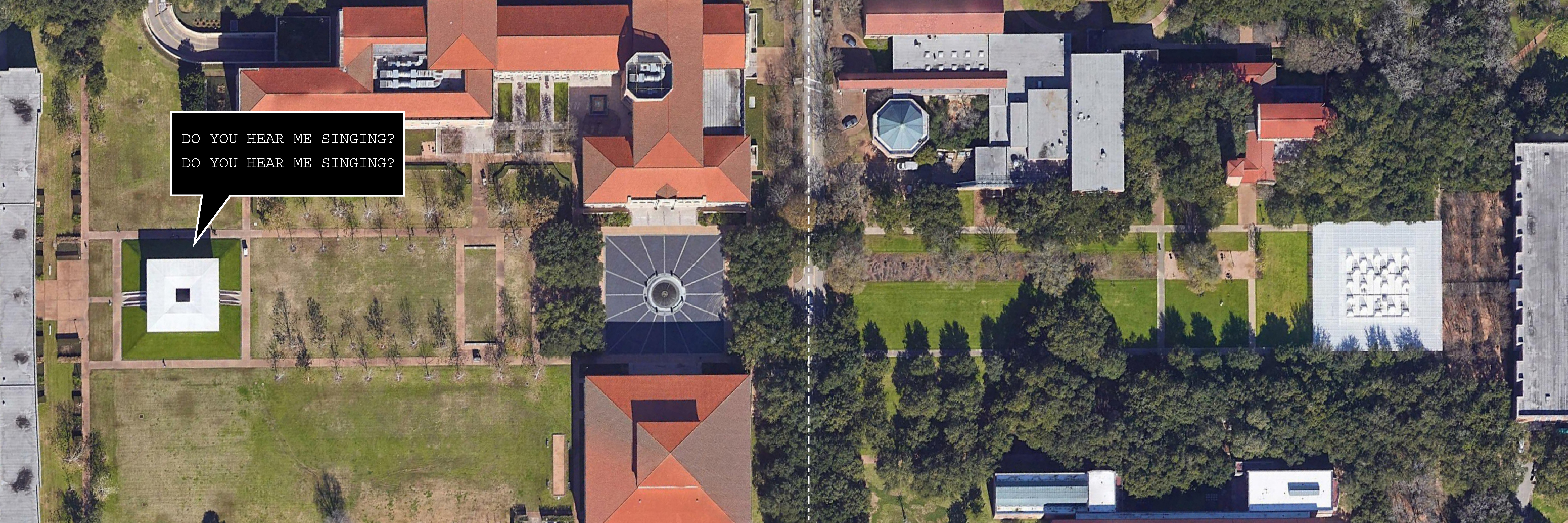Do You Hear Me Singing
Contributor
Missed Calls

On the campus of Rice University, James Turrell’s Skyspace stands on an open field, with rows of sycamore trees flanking its entrance on one side and the School of Music’s building forming an impenetrable termination on the other. The Skyspace, with its more proper name Twilight Epiphany, is an artwork commissioned by alumna Suzanne Deal Booth, who also serves as a member of the Rice Public Art Committee. An information plate installed at one of the entrances further declares the structure’s prescribed self-consciousness as a piece of art.
However, the entire construction is typologically a union of Le Corbusier’s Dom-Ino nestled on top of a pyramidal ground, with a skylight in the thin roof supported by slender columns. By conventional measurement it has all three elements that make an essential architecture: vertical structures, transverse shelters, and apertures for admissions of either humans or light and air. The first two elements are exquisitely displayed in the illustration of the primitive hut accompanying Laugier’s Essai sur l’architecture 1 . The third element, though not explicitly highlighted, is nevertheless one integral part of Laugier’s analyses in written form.
Across two quadrangles from the Skyspace is the Brochstein Pavilion, a small cafe designed by the New York-based architectural firm Thomas Phifer and Partners. The Pavilion, similar to the Skyspace, is known for its minimum structure and seemingly weightless roofline. The Alumni Dr. running across the quadrangles marks a mirroring plane. Standing along this line of symmetry, looking towards either one’s left or right, one can never miss the alarming similarities between the two structures – they are long-lost twins, albeit residing in separated disciplinary worlds as the metaphor of the mirror well indicates.
In assigning the Skyspace to the art realm while asserting that the Brochstein Pavilion is an archetypal building with practical functions, are we missing some latent messages from them? At times, when hosting concerts by music students, the Skyspace awakened and made its presence heard: “Do you hear me singing? Do you hear ME singing?” It declared, in exhilaration, its utilitarian status in becoming an event space. However, this euphoric call, though haunting for me, seemed to have its signal cut short by the Alumni Dr. mirroring plane. The Brochstein Pavilion – and subsequently its bustling visitors – chose not to hear, and the missed call became the sound of silence.
In separating the production of architecture from that of art, Robin Evans once said that “the most remarkable properties of Turrell’s installations are local and not transportable.”2 However, the transient light effect within the space by Turrell is comparable to a similar effect under the canopy of the Brochstein Pavilion. In denying the Skyspace’s status as more than a piece of art, the architectural discipline is severing itself from an evolving world scene.
Yet this is not to say that the Skyspace would defend itself as a piece of architecture. Rather, residing in an era characterized by a drastically changing relationship between art and architecture, the Skyspace wants to caution us against the ease with which such slippery classifications can be made. To borrow Rosalind Krauss’s famous coordinate system, the Skyspace lies somewhere as an “axiomatic structure” – an artwork that is in its essence architecture and non-architecture simultaneously.3 Comparatively, the Brochstein Pavilion should not be interpreted as purely a piece of architecture defined by its precise functionality. As light penetrates its permeable sunshade, the Pavilion similarly straddles the border between art and architecture.
In such a state concurrently within and outside of the discipline, maybe the message from the Skyspace to the Brochstein Pavilion, from art to architecture, could finally find a bypass to overcome the dichotomy of two mirroring worlds.
“Do you hear me singing?” The Skyspace vibrates with the music.
“Do you hear me singing?” The fold rustles in the wind.
Do you hear me singing?
- The drawing that I am alluding to is “allegory of architecture”, the frontispiece to the second edition of Marc-Antoine Laugier’s Essai sur l’architecture, drawn by Charles-Dominique-Joseph Eisen. ↩︎
- Robin Evans, “Translations from Drawing to Building,” in Translations from Drawing to Building, (Cambridge, MA: The MIT Press, 1997), 159. ↩︎
- See Rosalind Krauss, “Sculpture in the Expanded Field,” in October, Vol.8. (Spring 1979), 30-44. ↩︎